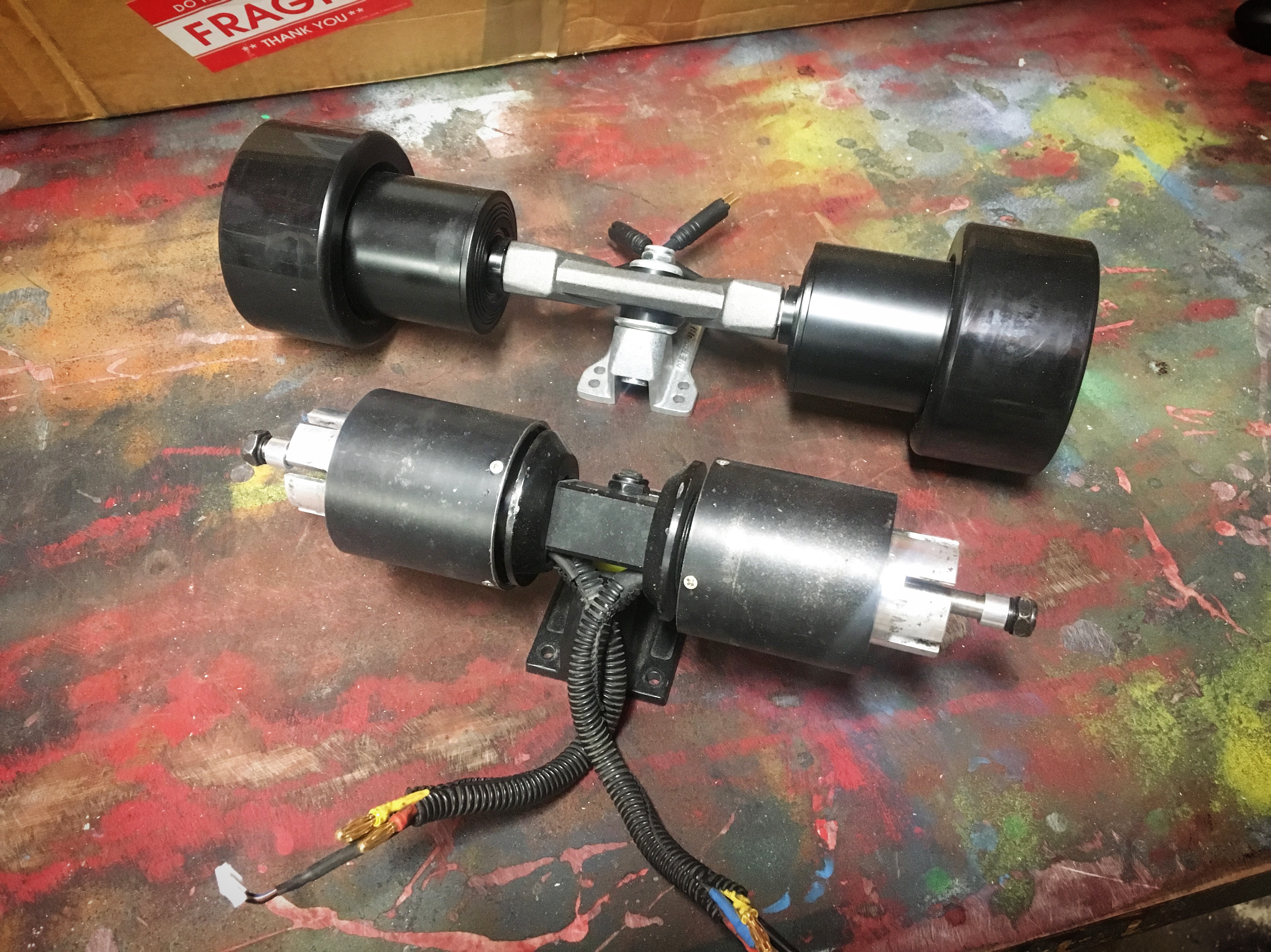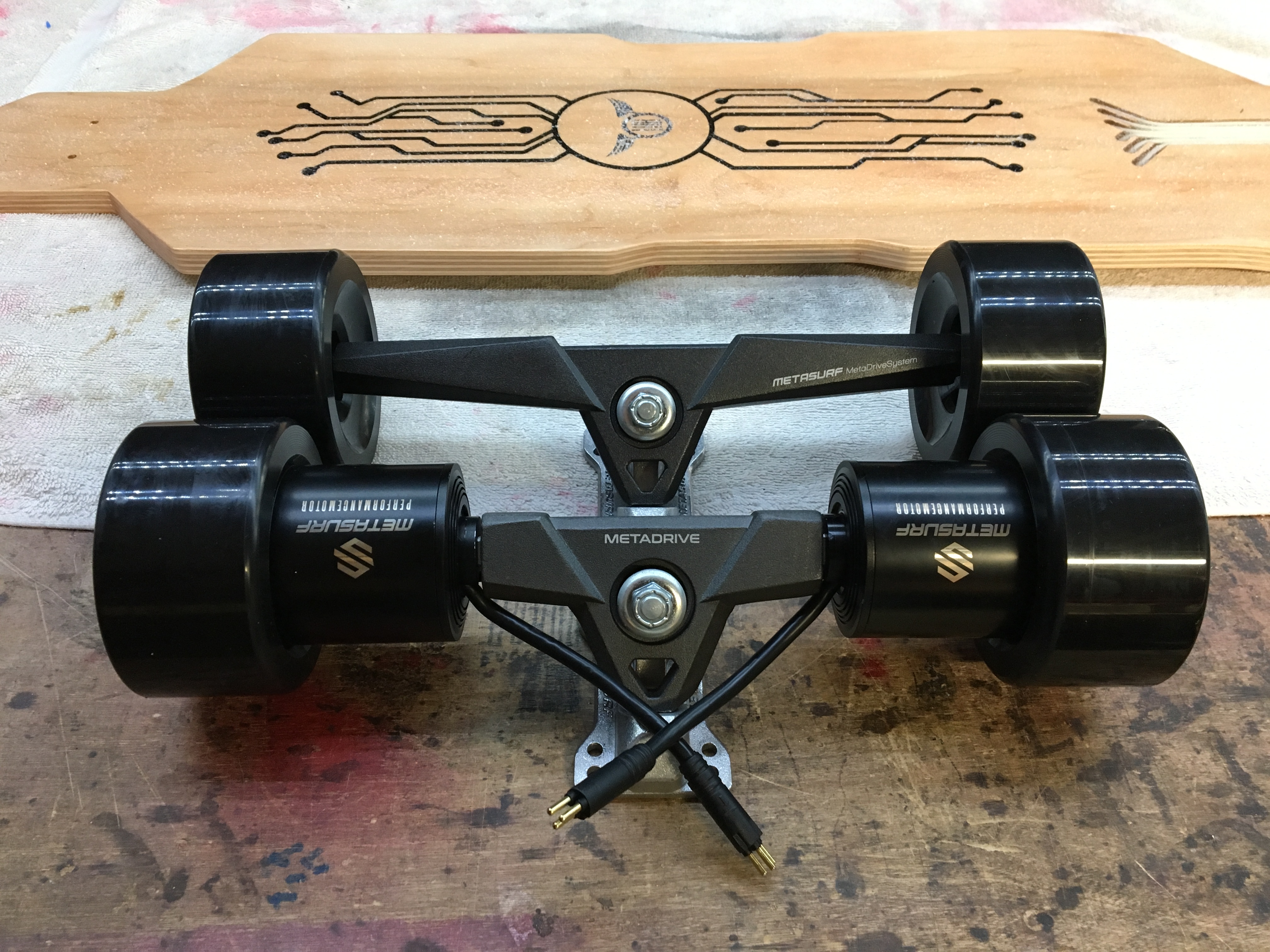
I’ve been building custom boards for a few years now. During that time I’ve tried a number of drive systems, but I always end up back on belts. Why? Because belts can deliver the perfect balance of low end torque and top end speed for any rider simply by changing the pulleys’ tooth counts. With that level of customization, why would anything else seem attractive? To answer that in one word: maintenance. Belts require more attention than direct drives and hub drives do. But while hub drives are wearing out sleeves and belts are picking up rocks, direct drives are happily chugging along with almost zero down time. And on direct drives, you can get some of that torque vs top end customizability back simply by swapping out the wheels with a larger or smaller compatible wheel.So why the hell isn’t everyone on direct drives? The answer to that is simultaneously slightly sensitive and pretty obvious: availability. A metric fuckton of people are very interested in this type of drive, in fact people have been literally standing in line for years to get them because for a while there was really only one option, and you were lucky to get it. Now there seems to be two options, and a third on the horizon from a well-known vendor. But for now, we’re going to discuss the two that are currently “available” and leave the third option for a later review.
The Meta Drive

Meta Surf. they sort of came out of nowhere, much like the rest of this industry. Except this time they were really not expected because I’m much more saturated in esk8 now than I was just last year. Who are they? Where did they come from? I don’t have all the answers for that, but i was able to acquire a set of their drives through an active community member who was thoughtful enough to grab them for us while over seas. They also seem to have a presence in San Francisco. I think what caught my attention the most, however, was that they are allegedly running their complete boards at 13S voltages. The highest end boards, including mine, typically run 12S, which is 44.4v nominal, as opposed to the 48.1v of 13S. OF course they also mention using FOCBOXes on their website and say they are swappable in minutes, so who knows what we’re actually dealing with. Somehow I doubt there are any Enertion products anywhere in this.
My first impressions were that it was polished, pretty, and probably going to bend almost immediately. The axles are just incredibly long. The stance is wider than an Evolve board (take your pick, they all run the same trucks) and is still only using 8mm axles. Now before you say anything about evolve not having to worry about bent axles so much, keep in mind that Evolve isn’t shaving the aluminum down and leaving several inches of bare 8mm axle so they can slide on a direct drive motor. While digging around the internet, I was able to find a few images of bent and broken Meta Drives, however i don’t think going deeper into the discussion about how flimsy they are is going to help anyone. They practically sag just sitting on the shelf.

Something more interesting about them, however, is the complete lack of sensors. Unless their ESC is magical, there will be no stutter free start. It’s possible that running these at higher voltages on an ESC that can do true FOC may mitigate some of that, but its not likely going to be anywhere as pleasant as sensors would. No matter how you slice it, if you don’t know where your flux is in relation to your coil, you’re going to have to guess. That guessing makes your board seem stuttery and less polished on launch. At the time of this writing, there were no complete Meta Surf boards available for me to try, so all of my impressions are gleaned only from their drive system.
In spite of that, we decided to strap them to a Bustin Maestro and see how they run. Due to the lack of a matching ESC, we strapped a well known system that works with hub drives rather well in both with and without sensors: a Koowheel ESC from an earlier model. The Koowheel runs a pair of hub drives with sensors at 10S, and was able to detect and run these Meta Drives rather well. But since we don’t have the intended ESC, or the intended 13S voltage, and no damned sensors, we’re going to be lenient regarding their performance.
That said, the performance was actually rather good. If you can get your mind past the idea that the axles on the rear truck are actively bending every time you stand on the board, it doesn’t feel so bad. The usual ride around the block yielded pleasant results. They have a lot of bottom end torque once they start rolling, but not much top end, which is typical of a lower KV motor. For Sunday cruising, this would be a decent drive system. Assuming you don’t mind waiting around for axles to bend. And you don’t mind accidentally footing the wheels because the stance is so ludicrously wide.
The Carvon XL

Carvon, on the other hand, has been involved with the esk8 community since, well, since there has been one, or so it seems from my perspective. If the only thing I had to go on was forum posts and urban legend, then I could easily claim that Carvon practically invented the hub drive before moving the motor gradually out of the wheel an inch at a time until it was sitting next to it, at which point the direct drive was born.
So aside from the obvious clout that Carvon has with the community, what makes their drives so special? Well, I mean just look at it. No crazy wide stance, huge motors, obvious heft to the parts, detachable cogs allowing different wheel types to be accommodated eventually, and very importantly, sensors. All that being said, they’re just built better. However, none of that matters if they don’t ride well, right?
In my time with the Carvon XLs over the past year, I have increasingly questioned my devotion to belts. I do not make that statement lightly. If, for only a minute, we dropped the whole “belts are higher maintenance” issue and assumed a perfect world where glass doesn’t end up in the pulley teeth, and all we have are two systems that work not only as intended but flawlessly, I think I may still choose the more well designed and hardened direct drives at this point for a number of reasons, not the least of which is the vastly reduced assembly time on complete boards.
The biggest reason for my perceived sudden shift in loyalty could also be that when I ride the Carvons I have a hard time remembering while accelerating and braking that I’m not on belts. The startup is super smooth and definitely powerful enough, even from a non-optimal standstill such as with the wheels sitting in a crack or a gutter slope. Climbing hills is a non-issue; in fact climbing hills at speeds approaching 30mph is not even an issue. They’re quiet, powerful, easy to install, and pretty much zero maintenance until you want to swap your wheels, which are easily changed out with just a skate tool. That last bit can also be said of the Meta Drives, or any other direct drive setup, of course. But when you add that in with the other gains, suddenly belts don’t seem so necessary in light of the Carvons. But the real magic comes in the free roll. The Carvons in some cases can add miles to your range just by eliminating belt-related inefficiencies that increase drag and rolling resistance. Free rolling happens a whole lot more on direct drives, which allows you to hyper mile more by only using the throttle to maintain speed, not constantly keeping it engaged to overcome rolling resistance from belts.
The Bad News
So what’s the catch? Obviously we all need to switch to Carvon drive systems now, right? Well, good luck. Carvon has been having a hell of a time keeping up with demand, in fact a lot of people would tell you that they just flat out are not keeping up at all. I probably wouldn’t even have my own set if I hadn’t been involved in getting some of their complete builds done for them. Suffice to say, they’re hard to get your hands on. But if you can, they’re so worth it.
So what do we do now? Well, we wait. Earlier I mentioned a third option. That option is the TorqueBoards Direct Drive system which was just released for preorder over black friday weekend, and man do they look tastey with thier 70mm cans and Kegel core compatible cogs. We will be providing a review of that system separately very soon, so stay tuned for that. If it arrives correct, as they say, then there’s a good chance that both Carvon and Meta Surf will be very upset and be forced to get their shit together or find another niche. However, we will reserve judgment on that until we have our hands on the new product and can give it a proper review. As for now, the only ones that should really be upset are Meta Surf. 13S is catchy and cool, but bent up axles are bullshit. And if you wanted, you could run the Carvons at 13S too. And just about any other drive system, for that matter.
- A Unique ESC: The Spintend Ubox - January 29, 2021
- Brian Boney Interview: Burning Wood For Fun And Profit - July 8, 2019
- Jeff Friesen Interview: Enertion, Unity, Remotes, and More - June 30, 2019
